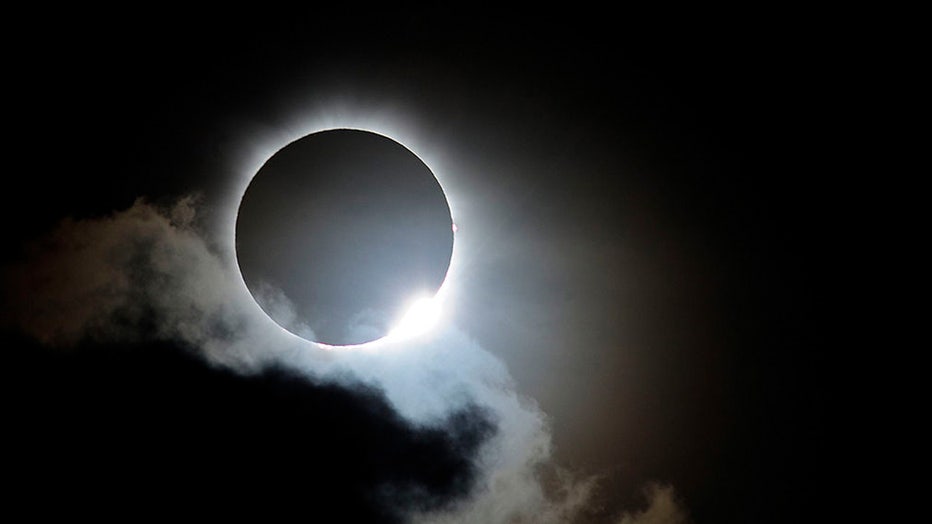2024 total solar eclipse: Why some states have issued warnings ahead of celestial event
Eye protection for April's total solar eclipse
If you’re among the millions of people who will get the chance to witness April’s total solar eclipse, you’re going to want to use eye protection. Vitreoretinal surgeon at New York Eye and Ear Infirmary of Mount Sinai Dr. Avnish Deobhakta joined FOX Weather on Sunday to explain the dangers of viewing the eclipse without proper eye protection.
Several states and some Texas counties that will be in the path of totality during the April solar eclipse have issued warnings and state of emergencies ahead of the event.
So far, several counties in Texas have issued official declarations, while the states of Oklahoma, Indiana, Ohio, Missouri, New York and Kentucky have alerted residents to be prepared ahead of the upcoming eclipse.
Several counties in Kentucky are even opting to close school for the day, according to a FOX 56 News report.
Residents who live in areas that will be highly trafficked during the eclipse have been advised to stock up on food, gas and other essential supplies as they prepare for an influx of visitors to witness the once-in-a-lifetime event.

FILE - Near totality is seen during the solar eclipse at Palm Cove on Nov. 14, 2012 in Palm Cove, Australia. (Ian Hitchcock/Getty Images)
Ohio
Ohio Gov. Mike DeWine signed Executive Order 2024-04D which directs all state departments and agencies to be ready and prepared to ensure the health and safety of residents and visitors.
"The safety and well-being of Ohioans is always at the forefront of everything we do," said DeWine, in a statement released on March 13. "We have been preparing for the April 8th solar eclipse for several years to ensure this once-in-a-lifetime event can be safe and memorable for all."
Ohio officials also said that there could be a potential for interruptions in cell service and strongly urged travelers to have a paper map to help them navigate.
Indiana
In Indiana, officials said traffic will be a major concern and encouraged any visitors to "stay in place after the eclipse" has taken place to avoid any severe traffic jams.
Oklahoma
In Oklahoma, state officials estimated there would be an influx of anywhere between 17,000 to 66,000 visitors to watch the event.
In addition to possible traffic jams, Oklahoma officials said it would be best for residents to schedule errands and appointments two to three days before the eclipse, according to the Oklahoma Department of Emergency Management.
Texas
Bell, Kerr, Travis, and Kendall counties have issued an official state of emergency and declaration of disaster.
"Projections are for this influx of people to begin occurring as early as several days before April 8th, with an outmigration occurring in the few hours immediately following the eclipse this year," Bell County Judge David Blackburn stated during a news conference in February. "If these numbers manifest themselves, the strain that this will put on our infrastructure will be significant. Everything from our first responders, to our health care systems, to our fueling stations, to our highways, to our emergency management stations and more. All of these could be severely strained by the influx of people."
Officials did not state why they suspect their community to be particularly hard hit by visitors, but it does sit along the busy Interstate 35 corridor between major metroplexes such as Dallas, Austin and Houston.
Other Texas cities that are in the path of totality in the Lone Star State include parts of San Antonio, Austin, Waco and Dallas-Fort Worth.
2024 total solar eclipse
The eclipse is expected to pass over Mexico’s Pacific coast, dashing up through Texas and Oklahoma, and crisscrossing the Midwest, mid-Atlantic and New England, before exiting over eastern Canada into the Atlantic.
In prime viewing spots, the totality will last over 4 minutes.
An estimated 44 million people live inside the 115-mile-wide (185-kilometer-wide) path of totality stretching from Mazatlán, Mexico to Newfoundland; about 32 million of them are in the U.S., guaranteeing jammed roads for the must-see celestial sensation.
North America won’t experience totality again until 2033, with Alaska getting sole dibs. Then that’s it until 2044, when totality will be confined to Western Canada, Montana and North Dakota.
There won’t be another U.S. eclipse, spanning coast to coast, until 2045. That one will stretch from Northern California all the way to Cape Canaveral, Florida.
The Associated Press and FOX Weather contributed to this report. This story was reported from Los Angeles.

